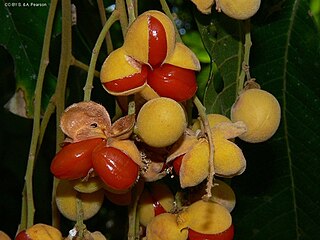
Rubus probus, commonly known as Atherton raspberry or wild raspberry, is a scrambling shrub in the family Rosaceae native to Malesia and Queensland.

Zieria smithii, commonly known as sandfly zieria, lanoline bush or Smithian zieria, is a plant in the citrus family Rutaceae and is endemic to eastern and south-eastern Australia. It is a robust shrub with its leaves composed of three leaflets, and groups of flowers with four white petals, the groups usually shorter than the leaves. It is common and widespread along the coast and adjacent ranges.

Opisthiolepis is a monotypic genus of trees in the macadamia family Proteaceae. The sole species is Opisthiolepis heterophylla, commonly known as blush silky oak, pink silky oak, brown silky oak or drunk rabbit. It was first described in 1952 and is endemic to a small part of northeastern Queensland, Australia.

Dysoxylum arborescens, commonly known in Australia as Mossman mahogany, is a small tree in the mahogany family Meliaceae. It is native to rainforests of Malesia, Papuasia, Queensland and nearby islands.

Corymbia bunites, commonly known as Blackdown yellowjacket, is a species of tall tree that is endemic to Queensland. It has rough bark on the trunk and branches, lance-shaped or curved adult leaves, flower buds in groups of seven, white flowers and barrel-shaped, urn-shaped or spherical fruit.
Zieria alata is a plant in the citrus family Rutaceae and is only found on mountains in the Mossman and Daintree areas in Queensland. It is an open shrub with wiry, lumpy branches, three-part leaves and small, white, cream-coloured or pale pink flowers in small groups, each with four petals and four stamens.
Zieria bifida is a plant in the citrus family Rutaceae and is only known from two areas near Nambour in Queensland. It is an open, straggly shrub with hairy branches, three-part leaves and small, white flowers in small groups, each flower with four petals and four stamens.
Zieria robertsiorum is a plant in the citrus family Rutaceae and is endemic to the wet tropics of far north-eastern Queensland. It is a shrub with leaves composed of three leaflets, and flowers with four white petals. The flowers are arranged in groups of up to ten which are no longer than the leaves.

Rubus gunnianus is a species in the genus Rubus of the family Rosaceae. It is a small herb that grows in subalpine and alpine habitats above 900m throughout Tasmania, and bears edible fruit. It is commonly known as the native strawberry or Tasmanian alpine raspberry.

Rubus pyramidalis is a species of bramble, a flowering plant in the rose family, native to northwest Europe.

Boronia excelsa is a plant in the citrus family Rutaceae and is endemic to a small area in Far North Queensland. It is an erect shrub with woolly-hairy branches, simple, stalkless, more or less hairless leaves, and pink to white, four-petalled flowers.
Leptospermum pallidum is a species of spreading shrub that is endemic to Queensland. It has thin, firm, rough bark, narrow lance-shaped leaves, white flowers arranged in groups of two or three on side shoots and fruit that remains on the plant until it dies.

Mucuna gigantea, commonly known as burny bean, burney bean, velvet bean or sea bean is a species of liana from the legume family Fabaceae. Its natural range roughly follows the perimeter of the Indian Ocean and includes Africa, India, Malesia, New Guinea and northern Australia. Many parts of the plant - in particular the new growth, flowers and fruit - are covered in fine irritant hairs.

Gardenia actinocarpa is a rare and endangered plant in the madder family Rubiaceae that grows in a very restricted area within the Wet Tropics rainforest of north-east Queensland.

Cerbera inflata, commonly known as the cassowary plum, grey milkwood, Joojooga, or rubber tree, is a plant in the family Apocynaceae endemic to north east Queensland, specifically the Atherton Tablelands and adjacent areas.

Argophyllum curtum is a plant in the Argophyllaceae family endemic to a small part of north eastern Queensland. It was described and named in 2018.

Dendrocnide cordifolia, commonly known as the stinging tree, is a plant in the nettle family Urticaceae endemic to the Atherton Tablelands, south west of Cairns, Queensland. Contact with the plant results in a painful sting, however the intensity and duration of the pain from this plant is extreme.
Hardenbergia perbrevidens is a species of flowering plant in the family Fabaceae and is endemic to Queensland. It is a twiner with slender stems, trifoliate leaves with narrowly egg-shaped to narrowly elliptic leaflets, and racemes of deep mauve to purple flowers with yellow marks.

Harpullia rhyticarpa, commonly known as slender harpullia, is a plant in the family Sapindaceae which is endemic to the rainforests northeastern Queensland, Australia.

Diploglottis obovata, commonly known as blunt-leaved tamarind, is a plant in the family Sapindaceae endemic to central eastern Queensland, Australia. Until 1987 it was considered to be a form of the very closely related Diploglottis diphyllostegia.






















